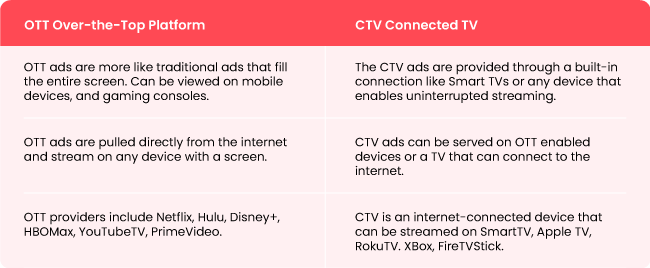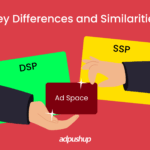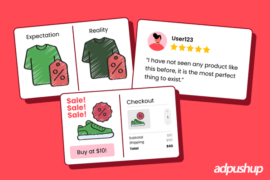
CTV vs OTT: Discover which platform offers the best advertising opportunities. Learn how to optimize your ad strategy, reach the right audience, and increase revenue through CTV and OTT.
The world has been moving from broadcast to digital video delivery. Cable TV and satellite TV have been overtaken by OTT and CTV advertising as they are now the preferred methods of delivering content to viewers around the world.
With billions of hours of binge-worthy content at our fingertips, streaming services have revolutionized entertainment. As a result, advertising on these platforms is booming. CTV and OTT advertising are gaining significant traction. However, the question on everyone’s mind is: “CTV vs OTT” – and what is better? And this is exactly why we have created this blog.
This blog will delve into the difference between OTT and CTV, use cases, and benefits for both publishers and advertisers.
Let’s first quickly understand what are CTV and OTT advertising.
CTV and OTT Explained
CTV and OTT are two terms that are often used interchangeably, let’s understand exactly what they are.
What is CTV Advertising? (CTV Meaning)
Before we get to CTV advertising, let’s understand what does CTV stand for.
CTV refers to the Connected TV, which is a device people use to stream TV shows. To put it in another way, it refers to any television set that can connect to the internet. It most commonly includes smart TVs, streaming devices, and gaming consoles.
Generally, when we say CTV, we refer to the device which is used to access the streamed video content. These CTV devices allow users to view OTT content on TV screens.
What is CTV Advertising?
Now, in CTV advertising, these are the video advertisements that are served between the content (Movies, series, etc.) through internet-connected television.
CTV advertising brings the precision and ad targeting capabilities of digital advertising, which makes it an impactful advertising solution.
What is OTT Advertising? (OTT Meaning)
OTT refers to Over-The-Top. which refers to a technology that displays digital content like movies, TV shows, podcasts, etc. via internet-connected devices.
When we say OTT, we typically refer to the publishers or OTT platforms that stream the video content.
What is OTT Advertising?
In OTT advertising, ads are served directly to viewers’ internet-connected devices through streaming platforms. Unlike traditional TV, it bypasses cable, broadcast, and satellite channels, offering a more targeted and data-driven approach to reaching audiences.
CTV vs OTT examples: Simple Examples for Easy Understanding
If you still have not gotten the hang of the difference between OTT and CTV advertising, let’s delve deeper and understand it better with CTV vs OTT examples.
Examples of CTV Advertising
Here are a few connected TV examples:
- Streaming services: Hulu, Netflix (ad-supported tier), Disney+, Peacock, Paramount+, etc.
- Smart TV operating systems: Samsung Tizen, LG webOS, Roku OS, Android TV
- Streaming devices: Roku, Apple TV, Amazon Fire TV, Chromecast
Examples of OTT advertising
You must have come across OTT advertising many times if you have watched series or movies on your mobile devices using certain apps. To better understand the examples of OTT advertising, let’s have a look at some of the most popular OTT platforms.
- NetflixAmazon
- Prime Video
- HuluDisney+
- HBO Max
Now that you are well-versed with OTT CTV definition, let’s have a look at the differences they share.
What is the Difference between CTV and OTT?
When it comes to CTV vs OTT, both platforms have their strengths and weaknesses, each has a unique way of serving different kind of audience.
1. Sophisticated Targeting Techniques
Advertisements on both these platforms are done contextually, thanks to their advanced targeting capabilities. Both OTT and CTV allow advertisers to deliver targeted advertisements.
However, what sets CTV and OTT apart in terms of advertising is the number of devices they can advertise on. Connected TV advertisements are limited to bigger screens like TVs. When it comes to OTT, the advertisements can be displayed across various devices like Smartphones, Tablets, PCs, etc.
2. Ad Formats
The kinds of advertisements on OTT and CTV vary in terms of ad format and creatives. Compared to CTV, publishers have more flexibility in ad formats in OTT. Here’s why:
CTV ads are typically longer and can last from 30 seconds to 1 minute. These longer advertisers are ideal for TV screens, giving users a TV-like watching experience. But that’s not the case with OTT advertising.
Let’s take YouTube as an OTT platform as an example. It comes with various ad formats like pre-roll, mid-roll, and even interactive ads. his variety provides advertisers with multiple options to creatively reach their audience and adapt their messaging to different contexts.
3. Tracking and Analytics
When it comes to measuring the effectiveness of the ad campaigns in CTV and OTT advertising, both platforms have different approaches.
Both OTT and CTV offer different metrics and tools for evaluating campaign effectiveness. CTV platforms usually provide detailed metrics like viewability and fill rates, but it depends on the platform’s capabilities.
Talking about OTT advertising, analytics, or measurement tools vary by publisher, and they may choose what metrics to share. And when it comes to CTV advertising, the measurement capabilities depend on the DSP (demand side platform) or media platform being used.
Now that we are through OTT vs CTV in terms of differences, let’s weigh their pricing model
4. Pricing Models
Whether you’re a publisher or an advertiser, it’s essential to understand the pricing models of each platform before deciding where to advertise.
CTV Pricing Model
CTV ads are bought programmatically through a Demand Side Platform (DSP) and appear as channel ads on the CTV channel’s site.
OTT Pricing Model
Now speaking of OTT publishers and their pricing models, they have multiple pricing modules available. This includes a subscription-based model, ad-support content, or even a mix of both.
- SVOD (subscription video on demand)
In SVOD, viewers pay a recurring fee to access content without ads, offering a steady revenue stream and a premium, ad-free experience. - TVOD (transactional video on demand)
Here, users pay for individual pieces of content on a per-view basis, providing flexibility without requiring a subscription. - AVOD (advertising-based video on demand)
In this case, content is available for free, with revenue generated through ads shown during the viewing experience. - Mix and match
As mentioned earlier, publishers can offer both subscription and ad-supported options, which allows users to choose between ad-free access or free content with ads.
Let’s have a quick look at the table below to find out what is the difference between OTT and CTV in a nutshell.

Now that we know what’s the difference between OTT and CTV, it’s time to take a look at some of their top features.
Top 3 Features of OTT and CTV Ads
Both advertising practices indeed share their differences. However, there are still some similarities between the two. So, let us know some common features that are still unique:
1. Types of Ads and Creatives
Undoubtedly, both advertising practices offer a modern way to share the message with a huge audience. Yet, advertisers and publishers need to understand this — since both formats follow different advertisement patterns, the ads need to be designed accordingly. For instance, CTV advertisements are more like cable TV advertisements. OTT advertisements are flexible in their creativity, length, and other aspects.
2. Ability to Target Audience
With a rising number of OTT and CTV, the potential for success for both ads is high. Also, the majority of the audience of such platforms is the youth of society, so metrics like age, gender, etc, can give publishers clear and more specific metrics to target their advertisements. Yet, CTV ads cannot be promoted to the entire OTT audience, or vice versa, since OTT can be accessed on small-screen devices as well.
3. Costing and Monetization Models
Speaking of OTT platforms, they may choose various solutions to provide monetization models, which can be either subscription-based, advertisement-based, or even a mix of both. However, things can be a bit different in the case of CTV. Because of these differences in monetization models, advertisement prices may also differ.
Advertisement costs may be charged through CPM (Cost per Mile) or CPCV (Cost per Complete View). In CPM, the payment is made per 1000 impressions, whereas in CPCV is paid for views on unskippable ads.
Moving further into the CTV vs OTT battle, it’s time to take a look at which platform outperforms the other in terms of benefits.
Top 5 Reasons Why Publishers Should Leverage OTT And CTV Ads
While the OTT publishers allow users to watch shows and movies whenever they want, on any device with the help of streaming services like Netflix, Amazon Prime and Hulu, CTV ads are targeted toward devices “connected” to the internet. This means smart TVs, streaming devices, and gaming consoles.
Over-the-top and CTV ads help target users of all ages, genders, education levels, interests, and locations (with precise geographic data) based on in-app behavior or user search history across multiple platforms.
1. Retargeting advertisements
Since the data provided by OTT and CTV stays relevant to the viewer’s behavior, it can be used to retarget the user with similar or the same advertisements over a certain period of time. In some cases, advertisers or publishers can even be provided with the first-party data.
2. Advance Metrics and Analytics
Only metrics or analytics can clearly depict a successful or failed campaign. So, OTT and CTV are there to give marketers various metrics and rates that provide authentic numbers of user behavior.
3. Brand Safety
OTT platforms and CTV options often cater to a huge customer base. Also, their popularity and trust among the people are a primary indicator of their privacy and security infrastructure.
4. Flexible Ad Placement
Each marketing campaign has its own requirements. So, OTT/CTV offers flexibility to marketers with their idea of when they want to post their ads or at what time.
Apart from ad placement, here are the other reasons why publishers must leverage CTV and OTT ads for improved revenue generation.
- Keeps up with a fast-growing and young global audience
- Engaging and impactful content formats
- High viewability rates
- Data transparency and microtargeting
- Reduced ad-costs
Digital programmatic advertising through OTT and CTV ads comes with its own sets of benefits, such as a lower minimum cost threshold, cheaper cross-platform blended CPMs, complex audience segmentation, and advanced reporting capabilities, which makes it a lucrative option for advertisers.
Listen to what CTV is on our podcast and build a deeper insight.
Are There Any Challenges for CTV and OTT Advertisements?
Definitely, there are. Despite the fact that advanced and feature-rich advertisements have become popular, they are still irritating to the viewer. So, the following are some OTT and CTV challenges that give a hard battle to both advertisers and publishers:
Unskippable Ads
Unskippable ads result in a larger number of ad views, but, it may lead to the disintegration of the viewer’s interest. Hence, the user may unsubscribe the OTT or CTV service itself.
CTV Ads Are Not Clickable
Even if the user finds the ad helpful for him or her, they may still have to make efforts to reach out to their phones and search manually. This may not be a challenge for OTT ads since they are clickable; CTV ads lack their points here.
Complex and Requires Technical Expertise
Here also, CTV ad placements are generally more complex in nature. Furthermore, due to progressive video marketing infra, professionals must stay updated with recent trends. Also, the field also demands technical expertise in various stages.
How to Maximize Ad Revenue with OTT & CTV?
Ad-supported video on demand (OTT) and channel-based advertising (CTV) is widely accepted as the two top ways to monetize ads on the web.
Advertisers need to consider several important factors when determining OTT and CTV strategies. They must define the target audience and their expectations, develop a go-to-market strategy, understand the visitor’s journey or ad experience, and test different delivery methods to see which one works best for them.
Leverage Programmatic Advertising
Programmatic CTV advertising seems to be the go-to option for marketers looking to reach modern customers at scale.
Mobile Phones vs Connected TVs
When targeting consumers, CTV advertising that is suitable for big screens is best. For APAC consumers, mobile-friendly OTT advertisements offer higher returns on your advertising spending.
Pick The Right Content
While commercials are unavoidable on AVOD, users may pay extra to avoid them on SVOD (except when consumers upgrade). Marketers may now reach more people in the US and APAC by advertising on AVOD programs.
Before implementing an omnichannel marketing strategy, marketers must first determine exactly who their target consumer base is and what they want. Data providers that provide global, accurate, and high-performing audience segments are critical to accomplishing this.
Here’s how you can pick the best one that suits your needs.
Strategies to Follow When Implementing OTT and CTV Ads
When optimizing for OTT CTV advertising, keep your marketing objectives to one clear goal. Don’t try to do too much here, as it can confuse and turn off your audience before taking the desired action.
It’s All About Your Audience
Understand your audience’s needs, and do not opt for a one-size-fits-all approach. Take your time, research, and plan your ad messaging around a specific customer profile.
CTA Makes All The Difference
Compared to other media platforms, OTT advertising is more engaging and visually appealing. Viewers cannot click on an OTT ad to reach your website, unlike social media or search ads. Hence, including a clear and compelling CTA is a must.
Don’t Be Afraid of Experimentation
In addition to creating effective CTAs, it’s important to test different over-the-top ads as part of your OTT advertising campaign. One way to do this is by splitting-testing two different versions of an ad or airing them on different platforms at once.
Consistency is The Key
Multiple audiences are now consuming media at the same time. By running media ads that promote your brand consistently and clearly, you can reach new audiences with ease. Showing your logo design, eye-catching images of your products or services, and CTA across all your ads helps greatly with brand recall.
Customize Your Ads for Multiple Devices
It’s not just laptops and smartphones—people are consuming video content on tablets, connected TVs and other devices. To ensure that your over-the-top ads appeal to users on all of these display types, use fluid grids, flexible images, larger texts and close-up shots.
Bring Out Your Story
Why should people buy from you? You know your audience. Use that knowledge to sell yourself better than the competition at a price you can afford. Craft an ad that shows viewers why they should watch. Don’t be afraid to get creative with your messaging, and make sure it’s clear, concise and non-preachy.
Digital is more than just the website. In today’s world, digital presence is about building a robust digital presence to stay relevant and thrive in the new normal. With new technology, brands are able to create personalized experiences for their audiences across all platforms, not just on the Internet.
This is where OTT publishers and CTV advertising come into play, where over-the-top ads are targeted and customized for you or your audience on different devices and touchpoints.
Top 7 OTT and CTV Platforms
Kickstart your OTT and CTV journey with these top-notch 7 platforms that are handpicked just for you.
Amazon Fire

Access all your favourite apps under one roof. Amazon Fire is a TV with an HDMI port and an internet connection. Quick and large reach.
Apple TV

Apple TV is a smart TV and streaming device that works with your iOS device to offer video, music and games. Massive audience reach.
Playstation

Playstation is a popular game console made by Sony that is used to stream videos and games. Perfect for niche audiences in sports and the online gaming space.
Netflix

A video streaming service that allows people to watch a wide variety of great TV shows and movies. Netflix is perfect for a global audience.
YouTubeTV

YouTubeTV is one of the most popular free video streaming platforms in the world, which enables both content creators and businesses to earn a profit from videos and advertisements on the platform.
Hulu

Hulu is a TV streaming service that allows users to watch live and on-demand TV shows and movies on Internet-connected devices. Helps reach a large audience faster.
Spotify

World’s top audio streaming service with a giant library of music, podcasts and videos offered through mobile devices and desktops. Spotify is great for targeting a global audience with niche interests.
It is becoming more and more important to advertise online, especially through OTT publishers. With advances in technology for viewing, viewing quality and reach, it is easier to view an ad campaign online rather than just in your local market.
Who Might be the Perfect Clients for OTT and CTV Ads?
While both advertisements are open to all, there are still a few major clients for these advertisements. In concise words, here is the list of those major clients:
- Selling agency media purchasers
- Chief marketing officers and brand ambassadors
- Owners of marketing agencies searching for a white-label option
- Franchisees and business owners
- Entertainment and media companies
- Brands with targeted marketing strategies
Out of these industries and sectors, anyone who wants to target a niche-rich audience is welcome for OTT and CTV advertisements.
Which Platform is Right for Publishers?
Publishers have the flexibility to choose between CTV (Connected TV) and OTT (Over-The-Top) platforms based on several key factors:
Audience: Who are you trying to reach? CTV can give you access to a larger audience, while OTT allows you to target more specific groups based on their viewing preferences.
Content: Think about the type of content you produce. Does it work better for traditional TV-style viewing (CTV), or is it more suited for on-demand streaming (OTT)?
Advertising Goals: What are you aiming for with your ads? If you’re focused on reaching as many people as possible, CTV might be the way to go. If you’re looking for more engagement and interaction, OTT could be a better fit.
Technology: Do you have the resources to manage ad delivery on both platforms, or are you better equipped for one over the other?
Revenue: Which platform offers better financial opportunities for your content?Ultimately, it’s about finding the right platform that aligns with your audience, content, and goals.
Now that we have discussed about CTV vs OTT, let’s have a look at what the data speaks about OTT vs connected TV.
Stats and Facts – CTV vs OTT
According to Statista, OTT video sector in the United States is on an upward trajectory, with anticipated revenues soaring to an astounding $132.90 billion by the year 2024.
According to Digital TV Research, media revenue from OTT and Connected TV advertising is expected to surpass $210 billion by 2026.
In recent news, Magnite has announced Magnite Streaming, a singular supply-side platform that merges technology from the Magnite CTV and SpotX platforms.
$25 billion was spent on CTV advertising in the U.S. in 2023, with continued growth projected2.
Magnite Streaming also provides advertisers with access to CTV and OTT inventory, audience targeting capabilities, and real-time reporting.
In 2022, the number of CTV users amounted to more than 110 million among Gen Z and Millennials.
Final Words on OTT vs CTV
Through OTT and CTV, publishers enjoy the benefits of targeting customers all at once, with high-quality content and branding that offers brand safety.
In addition, publishing through these channels provides publishers with the opportunity to track the metrics of their campaigns in order to understand engagement and the effectiveness of their advertising.
With the growing popularity of OTT and CTV advertising for publishers, these platforms will undoubtedly help draw larger ad spending and continue to increase their market share.
So are you ready to boost your return on ad spend on OTT and CTV advertising campaigns? Sign up here to grow your ad revenue by upto 40% with a Google Certified Publishing Partner.
FAQs – CTV vs OTT for Publishers
You first need to determine your target audience to advertise on OTT publishers through Connected TV advertising. Then, you can use one of a variety of types of ads for the platform – video ads, text ads, and banner ads.
There are 2 types of over-the-top ad insertion methods — CSAI and SSAI
CSAI works by making calls from the video player to an ad server that responds to the ad. On the other hand, SSAI works by seamlessly integrating the ad media directly into the video stream without making any calls to a server to receive ads.
Connected TV advertising and OTT for publishers have several advantages over other platforms. First, it’s convenient and easy to advertise your content on the market due to the ideal size of each advertisement. It helps target niche audiences for improved results.
Second, you can use special modes that allow advertisers to create their own ads at the same level of advertising complexity and flexibility as in TV and radio broadcasts. Thirdly, they are cost-effective and offer insightful reports on various ad campaigns.
The eight most popular OTT publishers and CTV platforms to promote your business through targeted ads are Netflix, YouTube, Hulu, The Roku Channel, Wowza, Apple TV, Playstation and Amazon Fire.
OTT and CTV platforms for publishers allow them to reach a wider audience within specific demographics and interests. The message will reach the target market based on engagement and consumer behaviour, driving consumer sales and brand recognition. It offers benefits such as wider audience reach, brand safety, effective result monitoring and reduced ad costs.
This is probably the easiest thing to do. Just follow a simple rule — if you encounter an advertisement on platforms like Netflix, Amazon Prime, Hulu, etc., it clearly is an OTT advertisement. In other words, if a viewer stands by simple requirements, including:
A device with an internet connection (even a mobile phone)
Uses an OTT platform
And then the viewer sees an ad—it’s an OTT advertisement.
Whereas, if you see an ad while watching TV with a streaming device, it’s a CTV ad. The key difference is that CTV ads specifically target viewers on connected TV devices.

Deepak has a keen eye for detail and a deep understanding of the ad tech landscape. Whether it’s through in-depth articles, thought-provoking insights, or compelling storytelling, he’s dedicated to helping people navigate the complex world of ad tech with the simplicity of his words.

![CTV vs OTT Advertising: Which one is a Right for Publishers and Advertisers? + [6 Bonus Strategies] Ott vs Ctv](https://www.adpushup.com/blog/wp-content/uploads/2023/02/Featured-Image-770x515.png)








